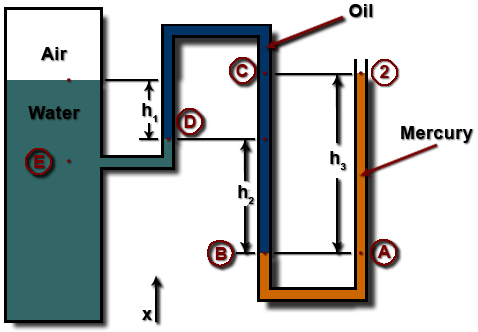| 1E-1 : | Pressure Measurement Using a Multi-Fluid Manometer | 6 pts | |||||
| The water in a tank is pressurized by air, and the pressure is measured by a multi-fluid manometer, as shown in the figure. Determine the gage pressure of air in the tank if h1 = 0.2 m, h2 = 0.3 m and h3 = 0.46 m. | |||||||
 |
|||||||
| Take the densities of water, oil and mercury to be 1000 kg/m3, 850 kg/m3 and 13,600 kg/m3, respectively. | |||||||
| Read : | Use the barometer equation to work your way through the different fluids from point 1 to point 2. | ||||||
| Remember that gage pressure is the difference between the absolute pressure and atmospheric pressure. | |||||||
| Given : | h1 | 0.20 | m | ρw | 1000 | kg/m3 | |
| h2 | 0.30 | m | ρoil | 850 | kg/m3 | ||
| h3 | 0.46 | m | ρHg | 13600 | kg/m3 | ||
| P2 | 101.325 | kPa | |||||
| Find : | P1,gage | ??? | |||||
| Solution : | Gage pressure is defined by : | Eqn 1 | |||||
| If we assume that P2 is atmospheric pressure, then Eqn 1 becomes : | |||||||
| Eqn 2 | |||||||
| The key equation is the Barometer Equation : | |||||||
| Eqn 3 | |||||||
| Now, apply Eqn 1 repeatedly to work our way from point 1 to point 2. | |||||||
| Some key observations are: | Eqn 4 | ||||||
| Eqn 5 | |||||||
| These are true because the points are connected by open tubing, the fluid is not flowing in this system and no change in the composition of the fluid occurs between A & B or C & D or D & E. | |||||||
| PA > P2, therefore : | Eqn 6 | ||||||
| PE > P1, therefore : | Eqn 7 | ||||||
| PB > PC, therefore : | Eqn 8 | ||||||
| Combine Eqns 2, 5 & 6 to get : | |||||||
| Eqn 9 | |||||||
| Use Eqns 3 & 5 to eliminate PC from Eqn 7 : | |||||||
| Eqn 10 | |||||||
| Now, solve for P1 - P2 : | |||||||
| Eqn 11 | |||||||
| Combining Eqns 10 & 2 yields : | |||||||
| Eqn 12 | |||||||
| Plugging values into Eqn 11 yields : | |||||||
| g | 9.8066 | m/s2 | P1,gage | 56888 | Pa gage | ||
| gC | 1 | kg-m/N-s2 | P1,gage | 56.89 | kPa gage | ||
| Answers : | P1,gage | 56.9 | kPa gage | ||||
| If you are curious : | P1 | 158.21 | kPa | ||||
| P2 | 101.325 | kPa | |||||
| PA = PB | 162.68 | kPa | |||||
| PC = PD = PE | 160.17 | kPa | |||||
Example Problem with Complete Solution
© B-Cubed, 2003, 2005, 2006. All rights reserved.

